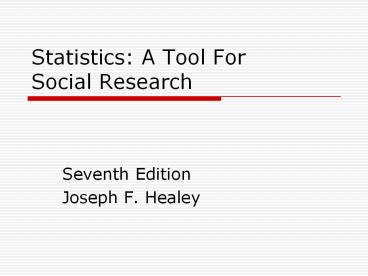Statistics: A Tool For Social Research PowerPoint PPT Presentation
Title: Statistics: A Tool For Social Research
1
Statistics A Tool ForSocial Research
- Seventh Edition
- Joseph F. Healey
2
Chapter 1
- Introduction
3
Chapter Outline
- Why Study Statistics?
- The Role of Statistics in Scientific Inquiry
- The Goals of This Text
- Descriptive and Inferential Statistics
- Discrete and Continuous Variables
- Level of Measurement
4
In This Presentation
- The role of statistics in the research process
- Statistical applications
- Types of variables
5
The Role Of Statistics
- Statistics are mathematical tools used to
organize, summarize, and manipulate data.
6
Data
- Scores on variables.
- Information expressed as numbers (quantitatively).
7
Variables
- Traits that can change values from case to case.
- Examples
- Age
- Gender
- Race
- Social class
8
Case
- The entity from which data is gathered.
- Examples
- People
- Groups
- States and nations
9
The Role Of StatisticsExample
- Describe the age of students in this class.
- Identify the following
- Variable
- Data
- Cases
- Appropriate statistics
10
The Role Of Statistics Example
- Variable is age.
- Data is the actual ages (or scores on the
variable age) 18, 22, 23, etc. - Cases are the students.
11
The Role Of Statistics Example
- Appropriate statistics include
- average - average age of students in this class
is 21.7 years. - percentage - 15 of students are older than 25
12
Statistical Applications
- Two main statistical applications
- Descriptive statistics
- Inferential statistics
13
Descriptive Statistics
- Summarize variables one at a time.
- Summarize the relationship between two or more
variables.
14
Descriptive Statistics
- Univariate descriptive statistics include
- Percentages, averages, and various charts and
graphs. - Example On the average, students are 20.3 years
of age.
15
Descriptive Statistics
- Bivariate descriptive statistics describe the
strength and direction of the relationship
between two variables. - Example Older students have higher GPAs.
16
Descriptive Statistics
- Multivariate descriptive statistics describe the
relationships between three or more variables. - Example Grades increase with age for females but
not for males.
17
Inferential Statistics
- Generalize from a sample to a population.
- Population includes all cases in which the
research is interested. - Samples include carefully chosen subsets of the
population.
18
Inferential Statistics
- Voter surveys are a common application of
inferential statistics. - Several thousand carefully selected voters are
interviewed about their voting intentions. - This information is used to estimate the
intentions of all voters (millions of people). - Example The Republican candidate will receive
about 42 of the vote.
19
Types Of Variables
- Variables may be
- Independent or dependent
- Discrete or continuous
- Nominal, ordinal, or interval-ratio
20
Types Of Variables
- In causal relationships
- CAUSE ? EFFECT
- independent variable ? dependent variable
21
Types Of Variables
- Discrete variables are measured in units that
cannot be subdivided. - Example Number of children
- Continuous variables are measured in a unit that
can be subdivided infinitely. - Example Age
22
Level Of Measurement
- The mathematical quality of the scores of a
variable. - Nominal - Scores are labels only, they are not
numbers. - Ordinal - Scores have some numerical quality and
can be ranked. - Interval-ratio - Scores are numbers.
23
Nominal Level Variables
- Scores are different from each other but cannot
be treated as numbers. - Examples
- Gender
- 1 Female, 2 Male
- Race
- 1 White, 2 Black, 3 Hispanic
- Religion
- 1 Protestant, 2 Catholic
24
Ordinal Level Variables
- Scores can be ranked from high to low or from
more to less. - Survey items that measure opinions and attitudes
are typically ordinal.
25
Ordinal Level Variables Example
- Do you agree or disagree that University Health
Services should offer free contraceptives? - A student that agreed would be more in favor than
a student who disagreed. - If you can distinguish between the scores of the
variable using terms such as more, less, higher,
or lower the variable is ordinal.
26
Interval-ratio Variables
- Scores are actual numbers and have a true zero
point and equal intervals between scores. - Examples
- Age (in years)
- Income (in dollars)
- Number of children
- A true zero point (0 no children)
- Equal intervals each child adds one unit
27
Level of Measurement
- Different statistics require different
mathematical operations (ranking, addition,
square root, etc.) - The level of measurement of a variable tells us
which statistics are permissible and appropriate.

